by GaryG
Repeat after me: it’s all about the people! And in my 30 years of “serious” participation in the watch hobby, I’ve met few, if any, more interesting individuals than William Massena Rohr, founder and leader of Massena Lab, and Luca Soprana, an independent complications specialist.
Massena is the better known of the two, among other things having led TimeZone and Antiquorum and been a long-time member of the Grand Prix d’Horlogerie de Genève’s jury. Soprana, on the other hand, is one of those figures we know exist but who is rarely known by name: the genius creators and makers behind many of today’s great watches are not credited for their contributions as a rule.
In recent years, Soprana has become more visible through his work with Jacob and Co. and on the upcoming Derek Pratt project. Late in 2021 for the first time his name appeared on a watch: the Old School in collaboration with Massena Lab.
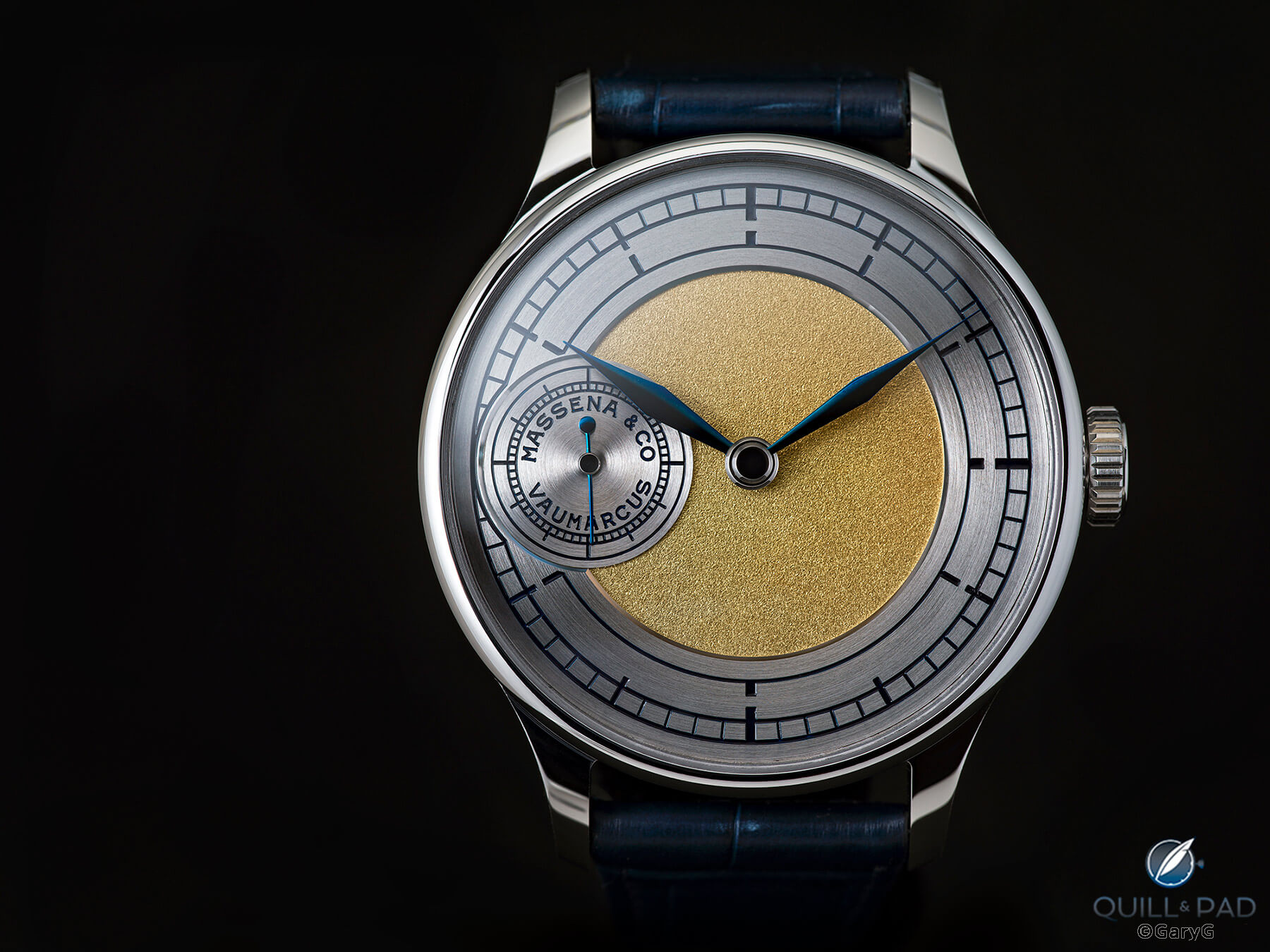
Old School by Massena Lab and Luca Soprana
Back to school
As you might expect, Old School is a take on the montre d’école concept: the pieces that watchmaking students complete prior to graduation, which display their newly acquired skills. Massena shared with me that the tongue-in-cheek “old school” reference failed to resonate with some audiences unfamiliar with American idioms, but as someone who knew the term (and who is a bit old school himself) I found it quite clever.
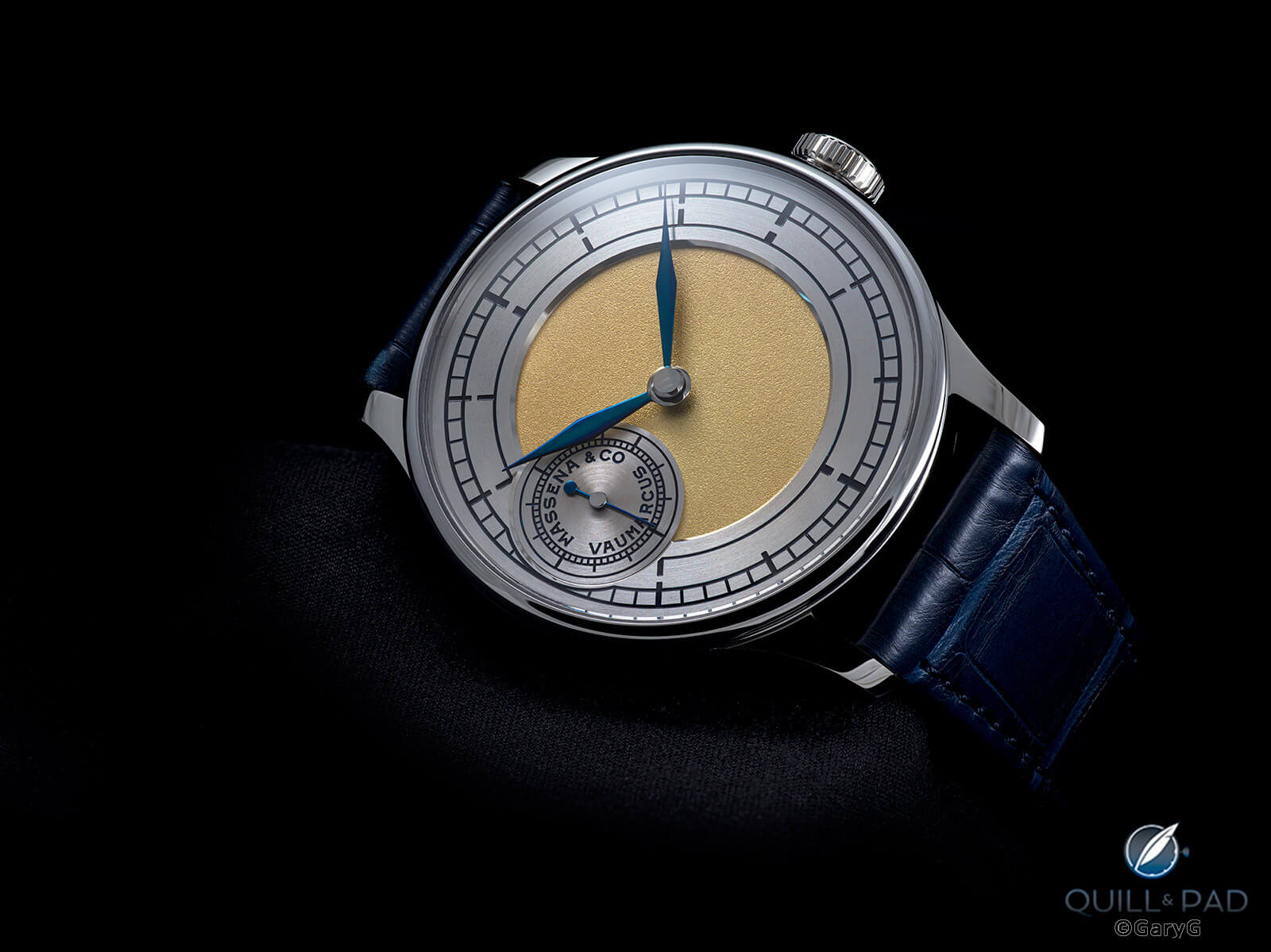
I say old school, you say ‘alte Schule’: Old School by Massena Lab and Luca Soprana
There’s a whole discourse to be had on the topic of school watches. A good friend makes a habit of scouring vintage watch shops in Switzerland in search of school watches by well known makers who subsequently sold them, and I’ve had the privilege of seeing several montres d’école still in possession of their makers, including Rexhep Rexhepi’s piece as seen below.
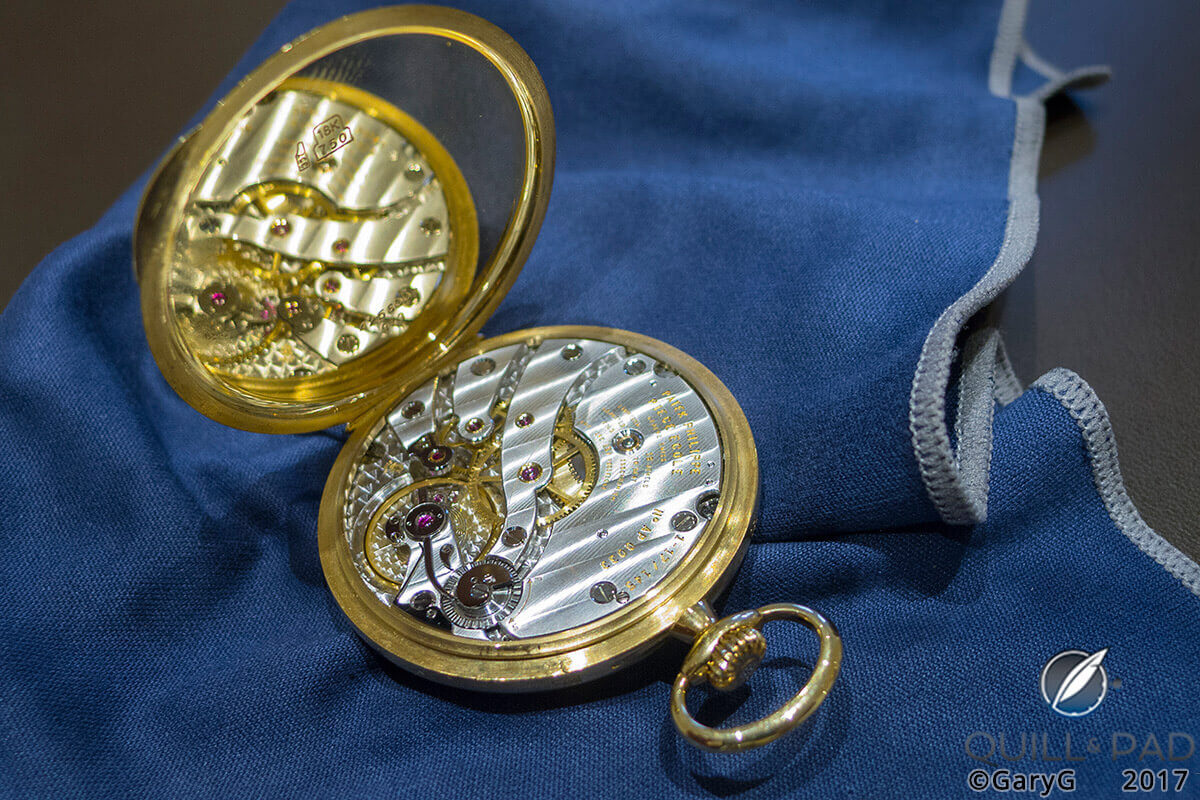
School daze: Rexhep Rexhepi’s montre d’école
Handmade
The hallmarks of a high-quality school watch are hand-making and high-quality decoration, and Old School delivers on both dimensions, beginning with the dial.
Before we get any further: I was delighted when Massena asked me to create a series of pre-launch photos for the Old School, and I am grateful for his permission to share them with you here. Importantly, the watch you see is very much a prototype (as labeled); in tight detail shots you might see some minor flaws, some screws on the movement side aren’t in final form, and so on – so please set your expectations accordingly.
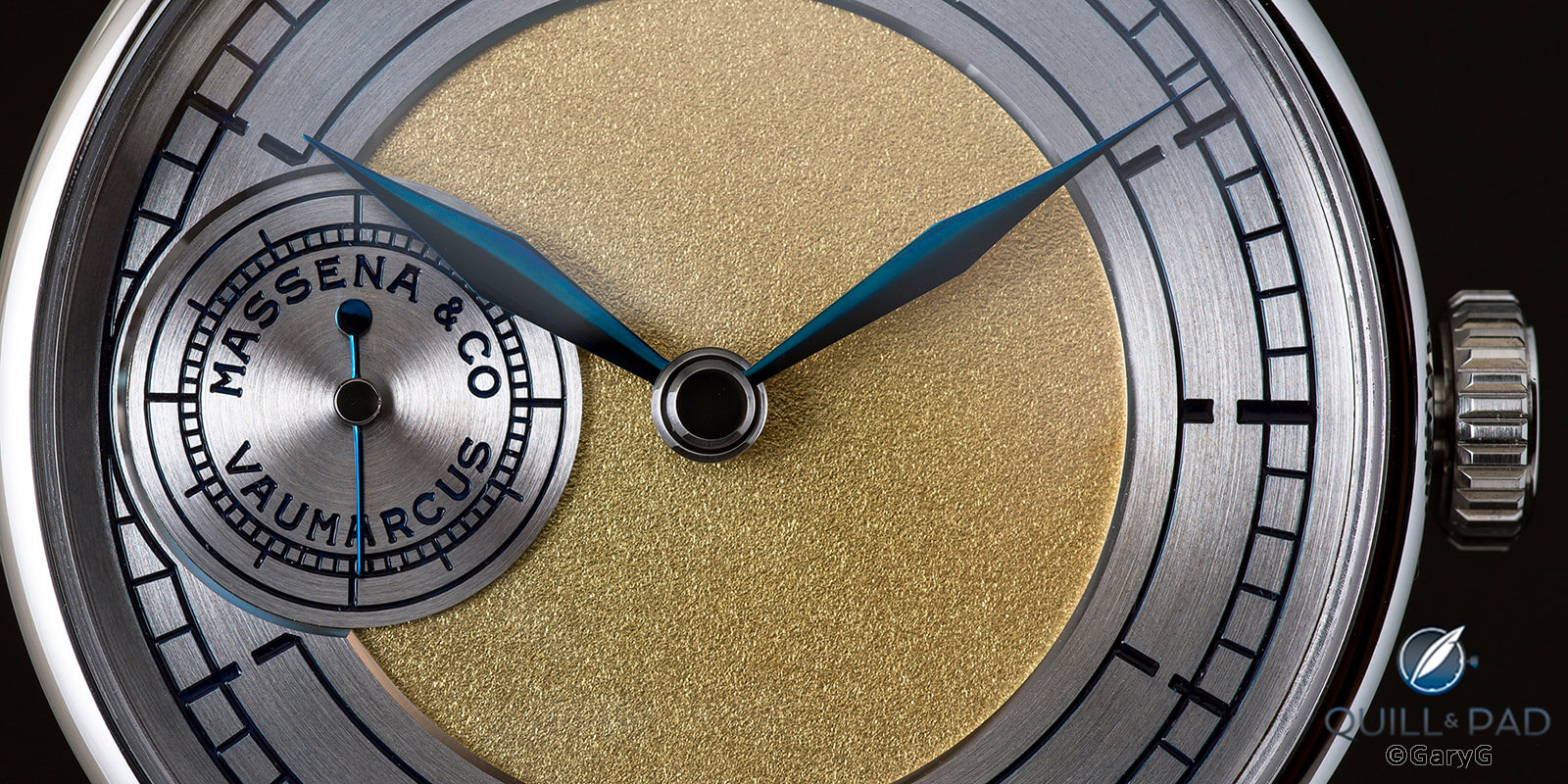
Dial detail, Massena Lab with Luca Soprana Old School
Back to the watch! In the photo above, you can see the fine hand-applied frosting of the central section of the dial and the radially brushed sector pattern surrounding it. The entire dial is in German silver, with the center area gold-plated after finishing and the other sections rhodium plated.
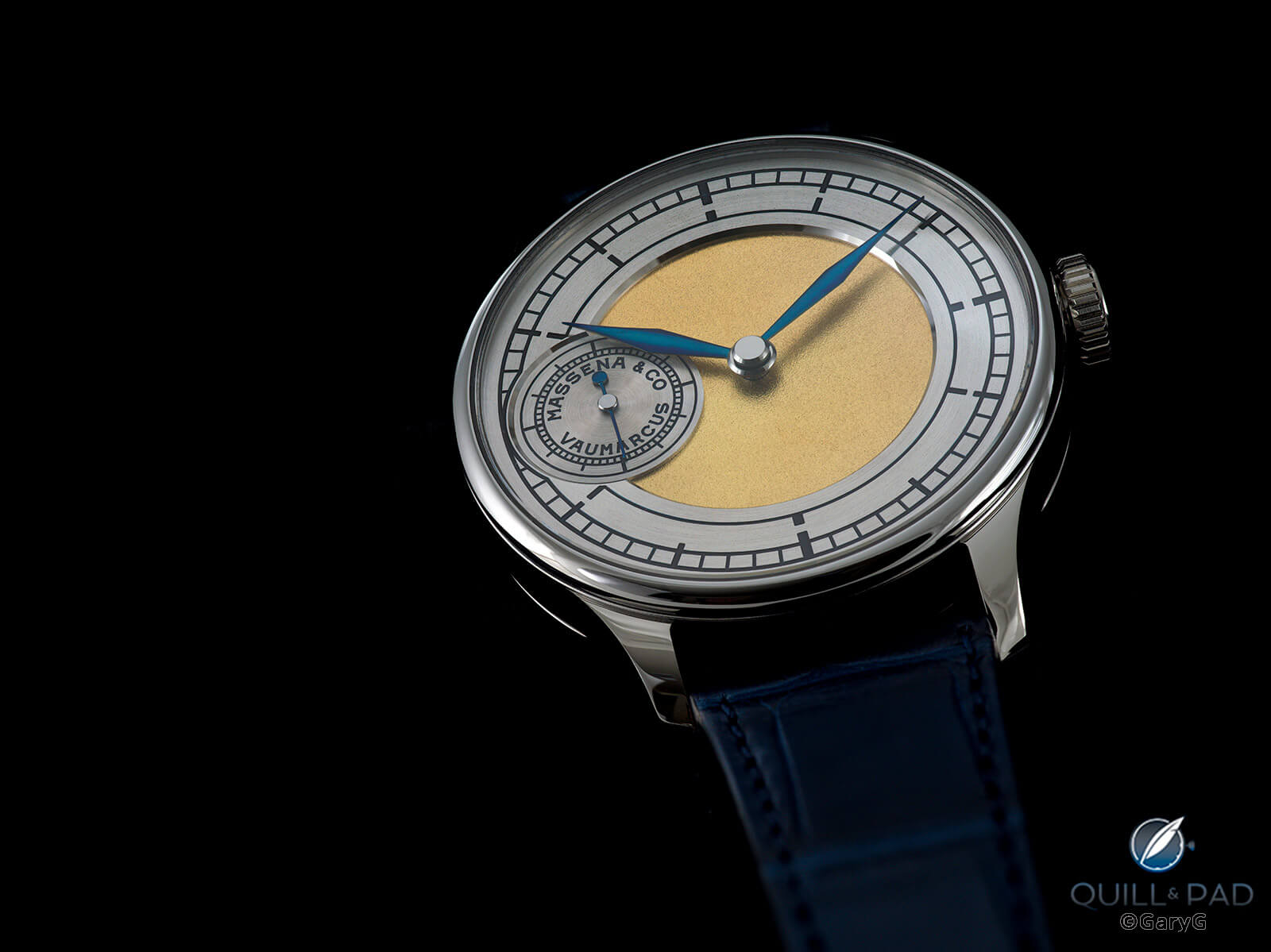
Check out those hands: Massena Lab x Luca Soprana Old School
On a dial as open and simple as this one, every detail counts, and for me the prominent and strongly curved hands very much do their part to add visual interest. I’m particularly drawn to the bold, beveled steel ring on the hour hand and similar caps on the minute and second hands.
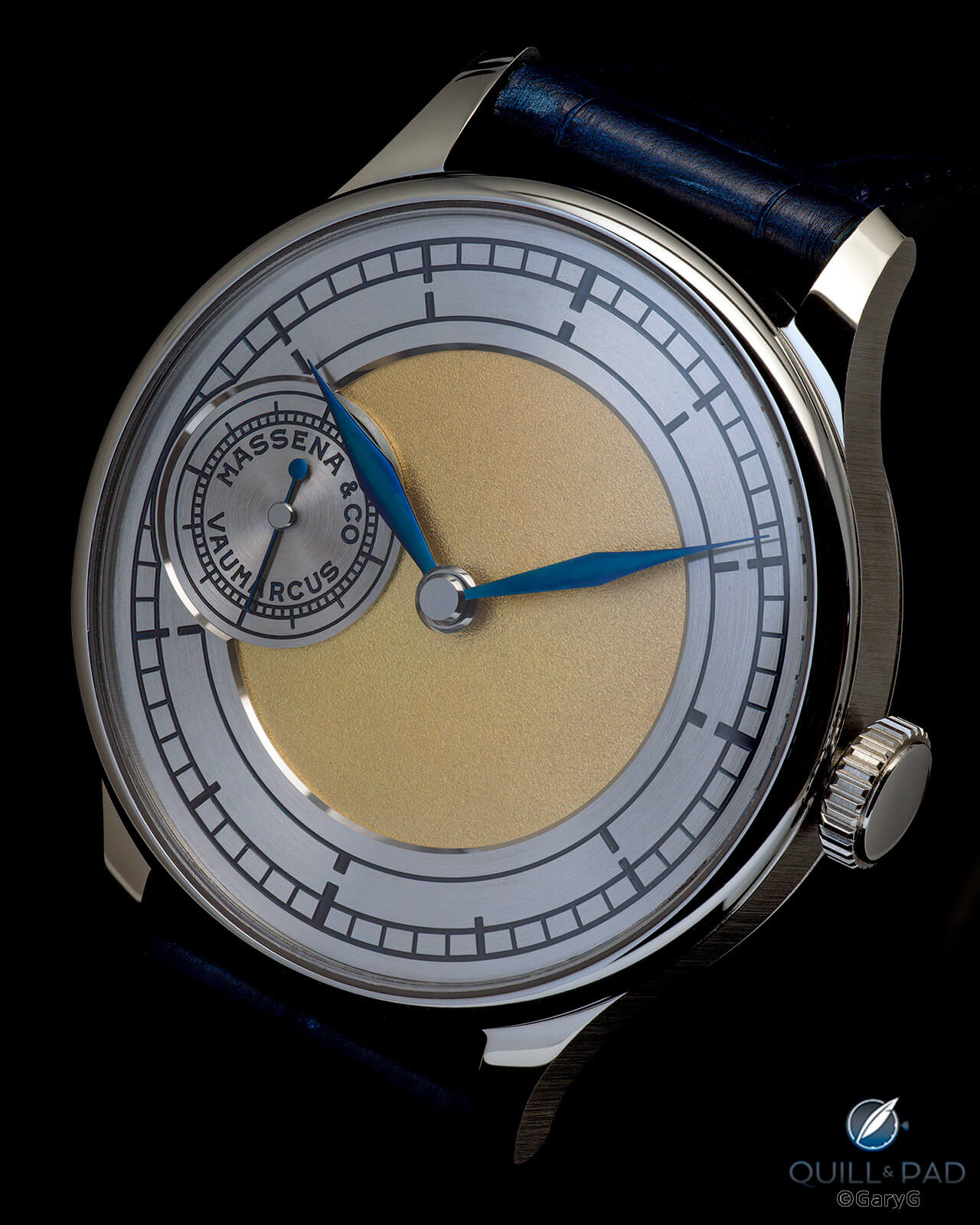
Crisp and clean: case shapes and finishing, Old School
The shapes and finishing of the case are not at all fancy, but to my eye are absolutely coherent with the inherent simplicity of the watch’s overall presentation. And in keeping with the hand-finishing theme, as we turn the case we’re greeted with very clear vertical brushing on the case band with its integrated lugs and the sharp angles of the handmade winding crown.
On to the back
Even in prototype form, the movement of the Old School is gorgeous. Soprana fills the entire back of the watch with a sea of German silver, appropriately finished in Germanic style starting with the simple-looking, but extremely difficult, full straight graining of the plate and bridges.
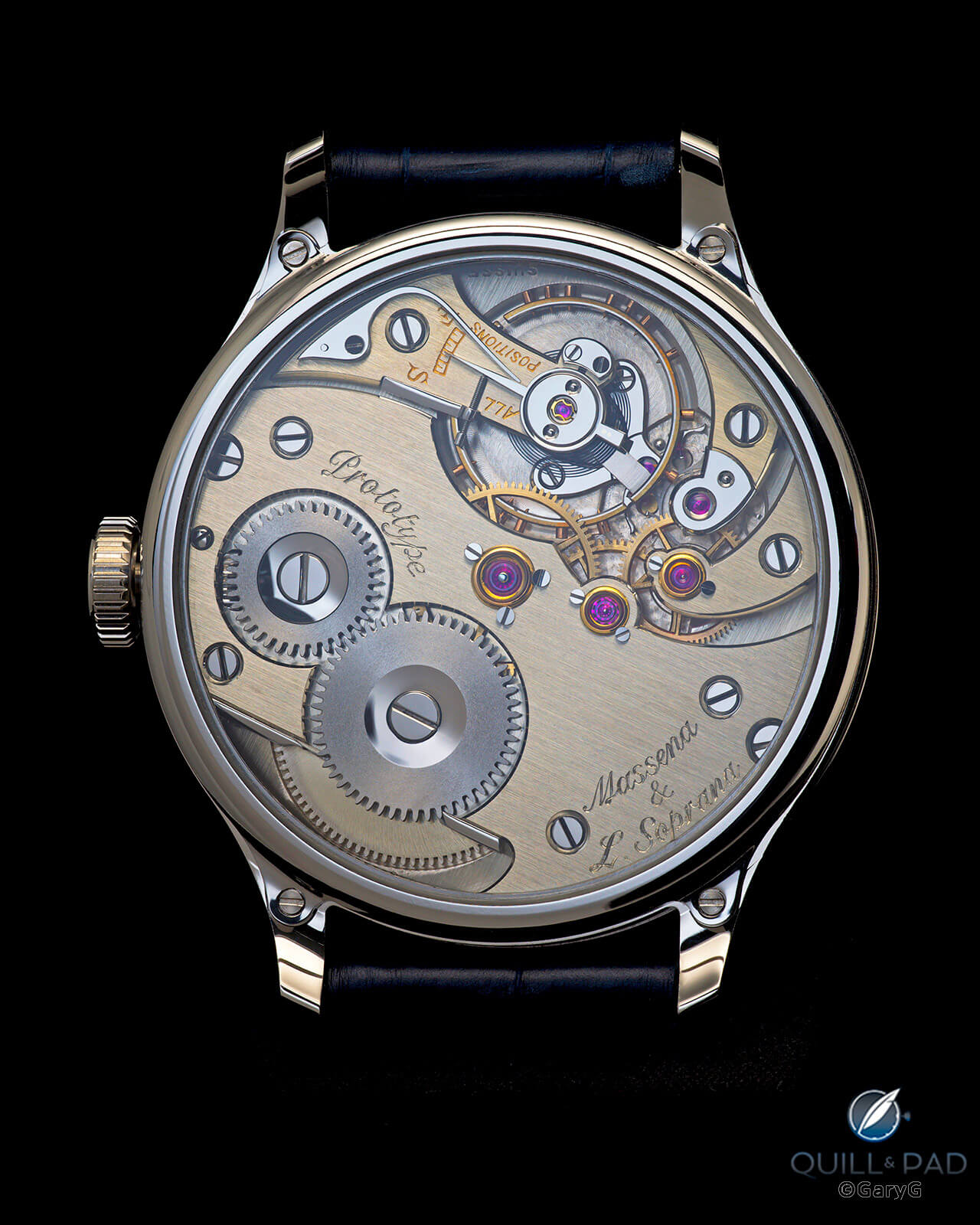
Caliber LS-01, Old School by Massena Lab with Luca Soprana
The tonal and color contrasts are already quite pleasant, and I suspect the effect will only improve as the German silver takes on its patina over time.
And while the movement looks quite straightforward at first inspection, a closer look reveals several lovely “old-school” touches: to start, take a look at the stylized swan neck adjuster for the balance seen at the top left of the movement in the image above.
Zooming in on the escapement, we find another feature that speaks to an earlier time: the bimetallic split escapement. If you want to understand how far our understanding of physics has advanced in a century, consider that in 1920 Charles Guillaume won the Nobel Prize in that discipline for his development of the bimetallic materials used in the temperature-compensating watch balance that bears his name. Times have certainly changed, but I for one welcome the Old School’s use of this technical throwback.
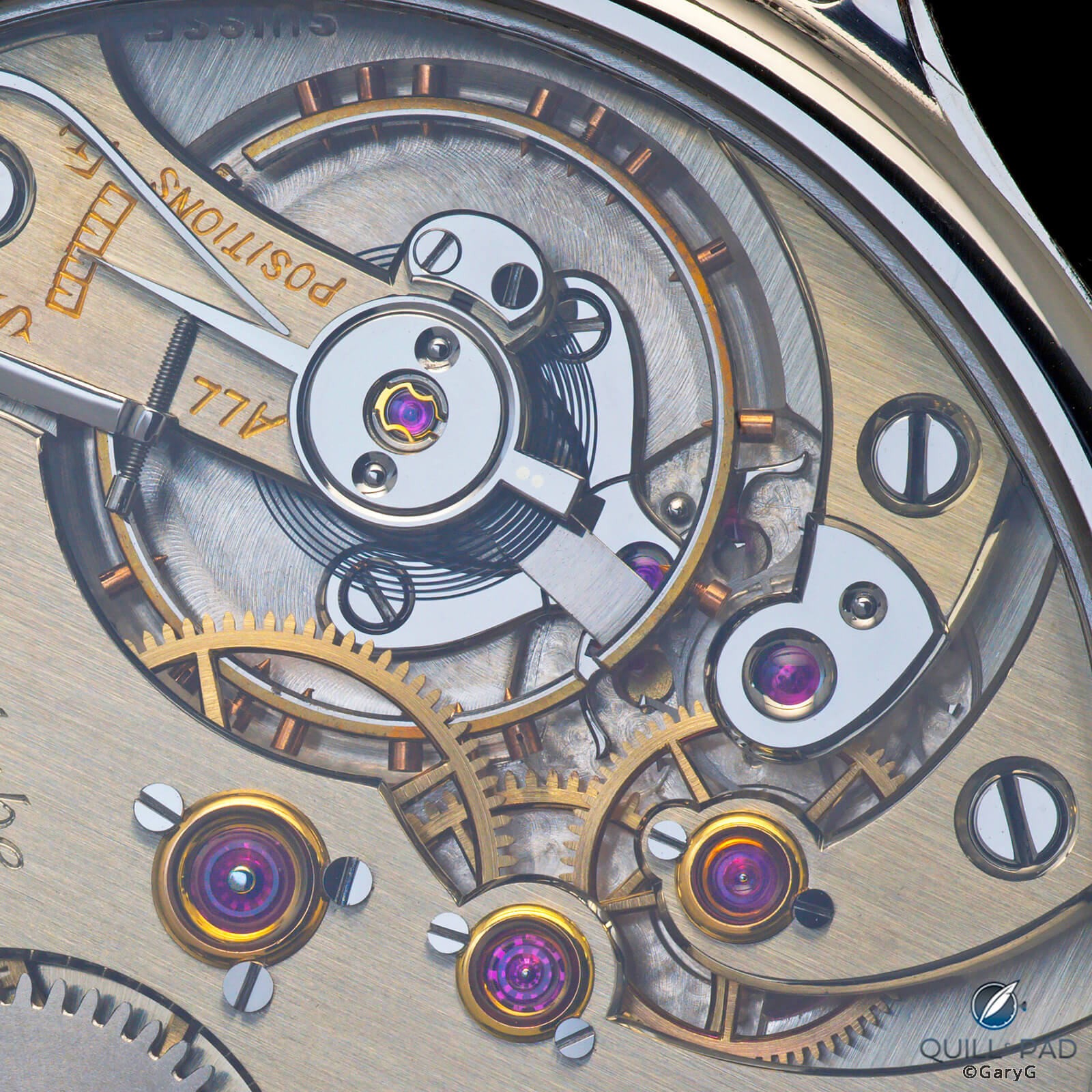
Escapement detail, Massena/Soprana Caliber LS-01
The other montre d’école hallmark, beautiful hand-finishing, is clearly in evidence on Caliber LS-01 as well. Continue looking at the image above and you’ll be able to see the black-polished caps and escapement bridge, sharp interior angles, smoothly rounded bevels, polished sinks, and jewels set in screwed, polished gold chatons. A lot of action in a small piece of real estate!
A short trip across to the other side of the movement rewards us with a view of the expanse of straight-grained German silver along with another old-time feature that I love, the straight-razor click visible at bottom left below.
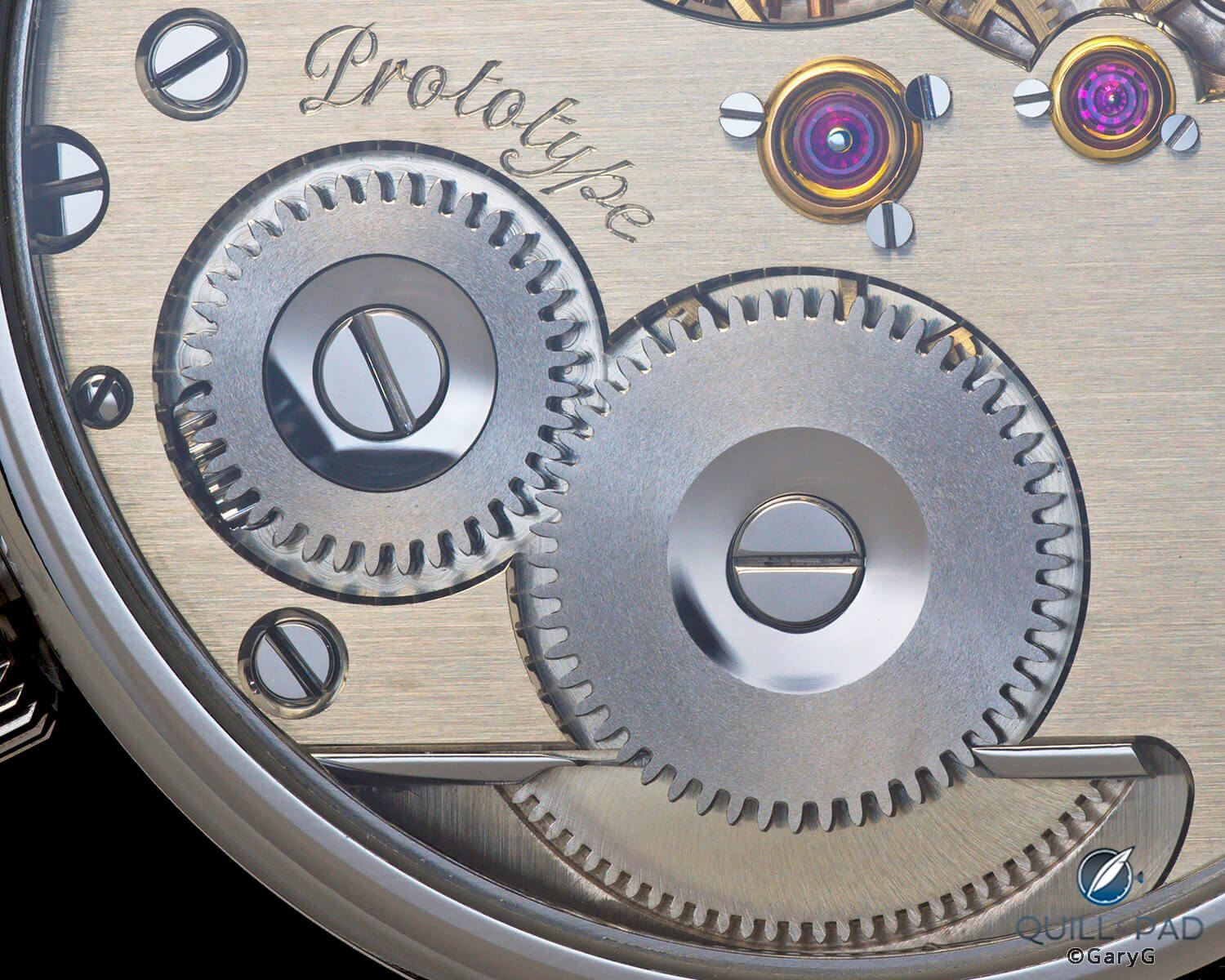
Close shave: at bottom left, razor click of Caliber LS-01
I own two outstanding watches with this style of click, the Dufour Simplicity and Rexhep Rexhepi RRCC, and the razor configuration not only looks good and provides an opportunity to show off finishing skills, but in my experience also yields a tactile and aural winding experience that’s very hard to match. I’m very pleased that this traditional element is finding its way into more high-end watches and happy to see it in the period-evoking Old School.

Case and movement perspective, Old School by Massena Lab and Luca Soprana
Whether seen up close or from a distance, for me Caliber LS-01 is an exercise in coherence; and, as seen above, that coherence extends to the movement as seen framed by the case, with the brushing on the movement plates finding its complement on the flanks of the case.
Before we leave the movement, I think it’s useful to shed some light on its origins. If like me you’ve read various articles written at the time of the Old School’s launch last fall, you’ll have seen various assertions and speculations about where Caliber LS-01 comes from, including suggestions that it is fully built up from a pocket watch ébauche.
When I corresponded with Soprana, he characterized the Old School as “a real school watch: that means an ébauche-based piece where the watchmaker makes many of the components” including in this case pivots, balance staff, chatons, and more. His estimate is that the finished watch includes 50 percent components developed and made at his atelier in Vaumarcus and 50 percent integrated, adjusted, and finely finished 1920s-era watch components.
In hand and on the wrist
If you do much watch photography, you quickly learn that there are some watches that look best in the diffuse yet directional light of the light tent and that others really hit their stride in direct light, whether indoors or out.
While I was quite pleased with how the Old School looked in studio conditions, a quick stroll into the back garden provided another, quite happy perspective.
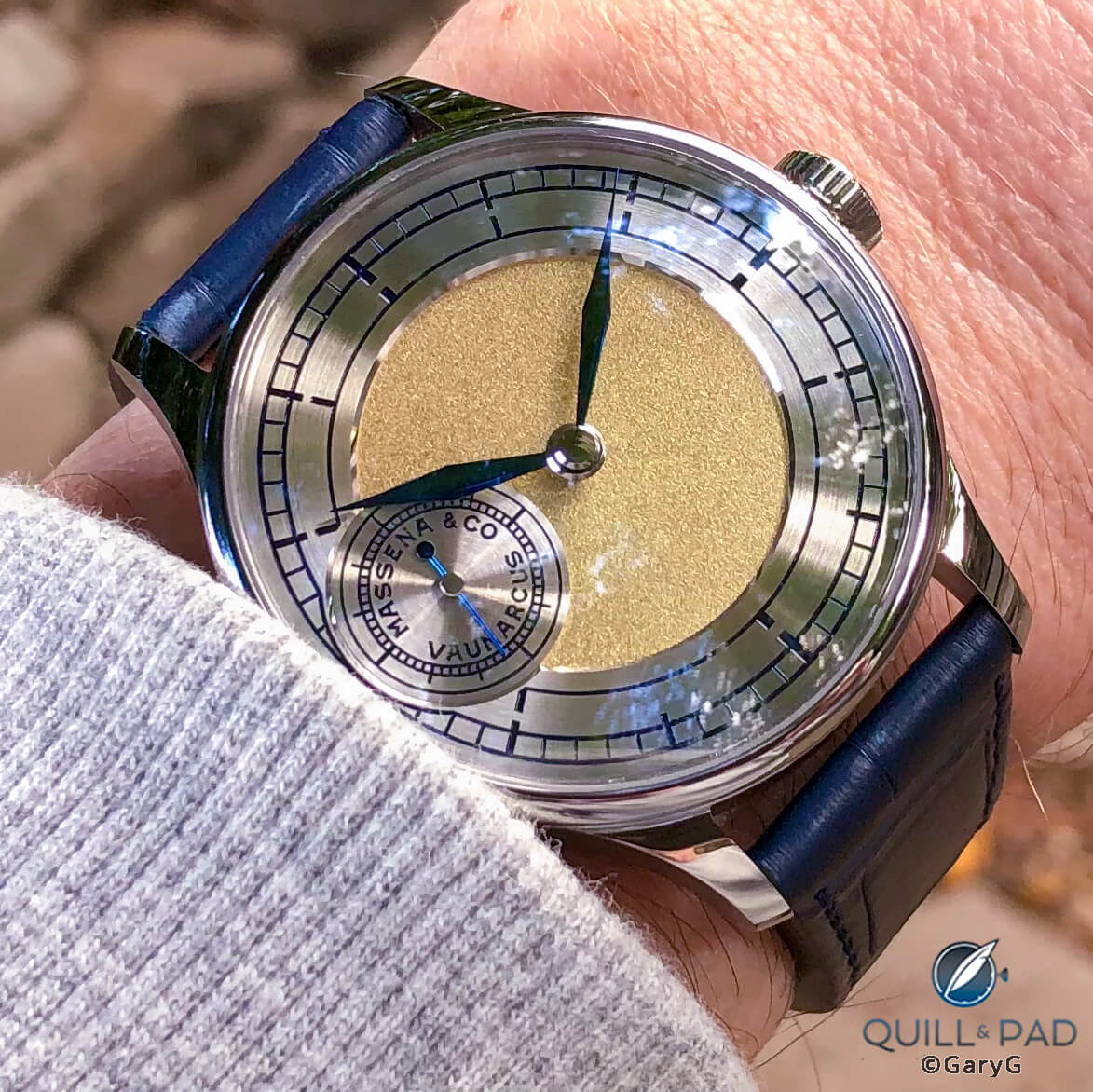
Watches are made to be worn: in the garden with Old School
This is a watch that comes to life on the wrist: as seen in the photo above, taken in dappled sunlight under the canopy of trees reflected in the crystal, the gold frosting shimmers, rhodium areas sparkle, and hands pop. Direct light also makes the midnight-blue enamel filling the indices more evident, making the dial a bit livelier and linking dial and hands more directly than is easily seen in subdued light.
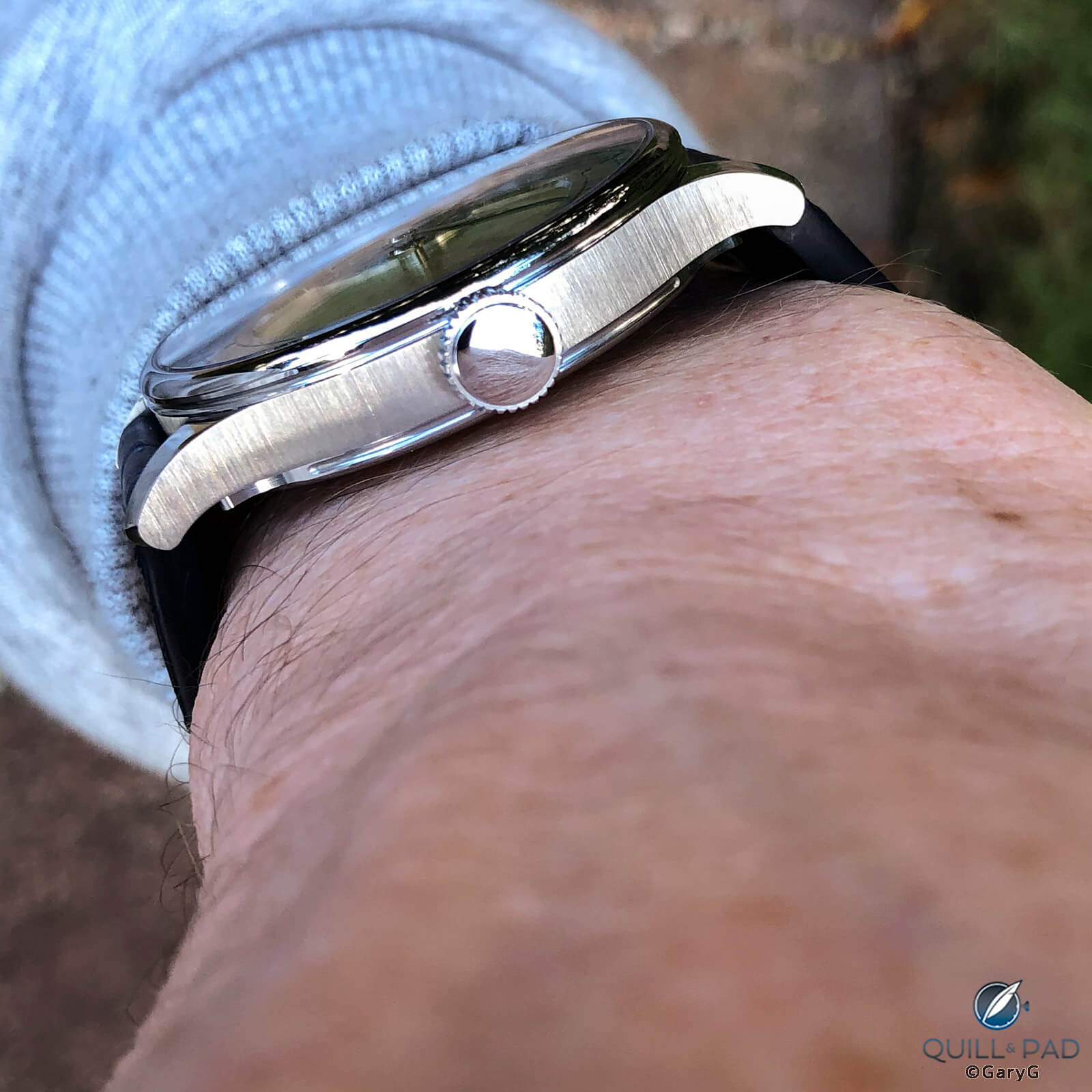
Case band view in direct light, Massena x Soprana Old School
Direct light also plays beautifully off the deep vertical brushing of the case band, a bonus for anyone who happens to catch a glimpse of this watch as it sneaks out from under the cuff.
Back inside, I flipped the watch over in bright office lighting and was so impressed by the vivid look that I grabbed an impromptu phone camera shot – perhaps not the most technically pleasing image, but one that I hope gives a sense of how the movement finishing catches and throws light.
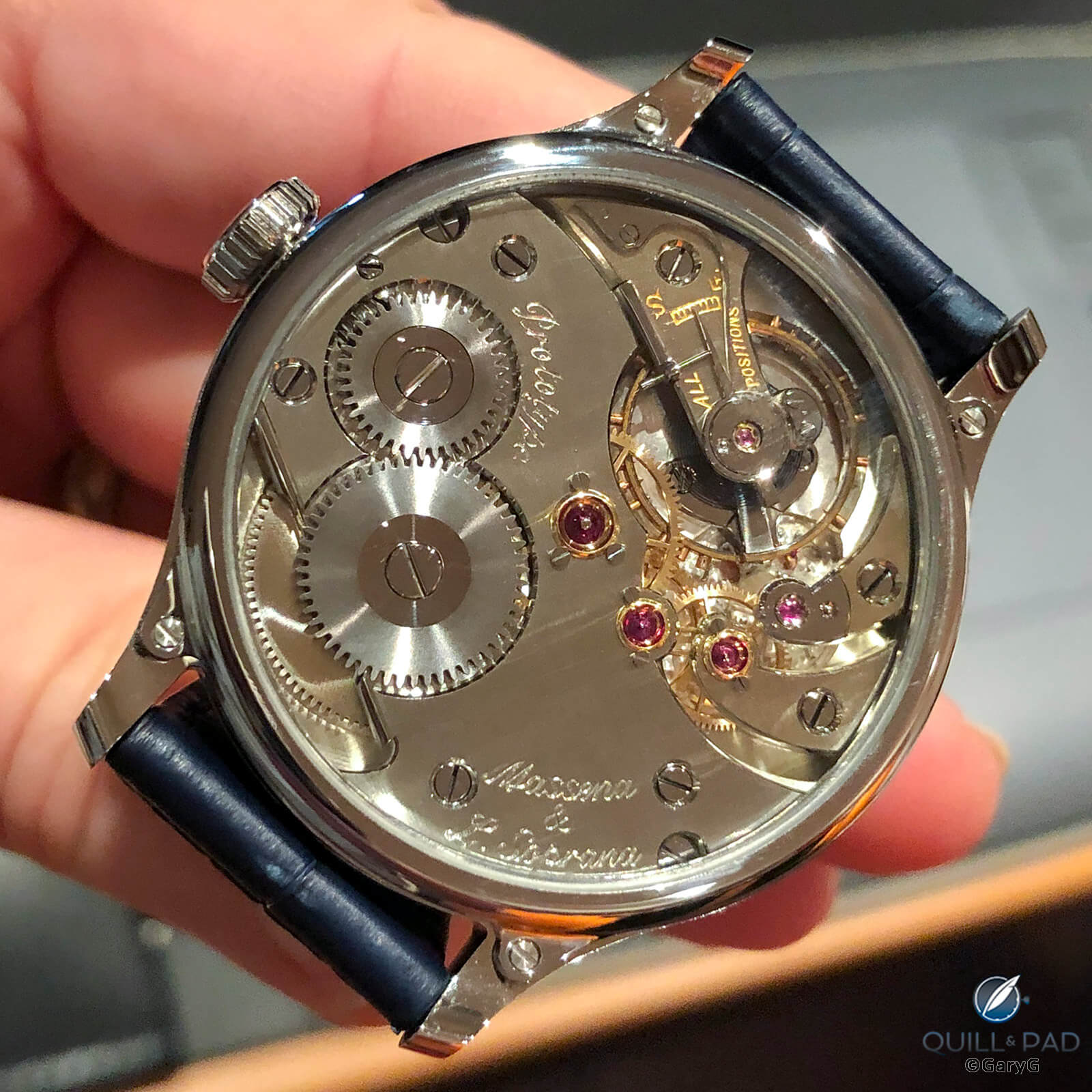
Movement view, Caliber LS-01 under bright interior lighting
Any quibbles?
Watch commentary is full of endearing/annoying clichés when it comes to the size of watches: gigantic pieces that “wear small,” tiny vintage items that “wear big,” and of course skyscraper-height domes that “slide nicely under the cuff.” I’m guilty of using all of those myself, so I’m not pointing fingers here!
Well, the Old School is a big watch (41.5 mm) that wears big. I have a broad, flat wrist, and even so you can see in my wristshots that this watch almost hangs over the edges. The thin bezels and bright tones also increase the impression of size as do the generously proportioned lugs.
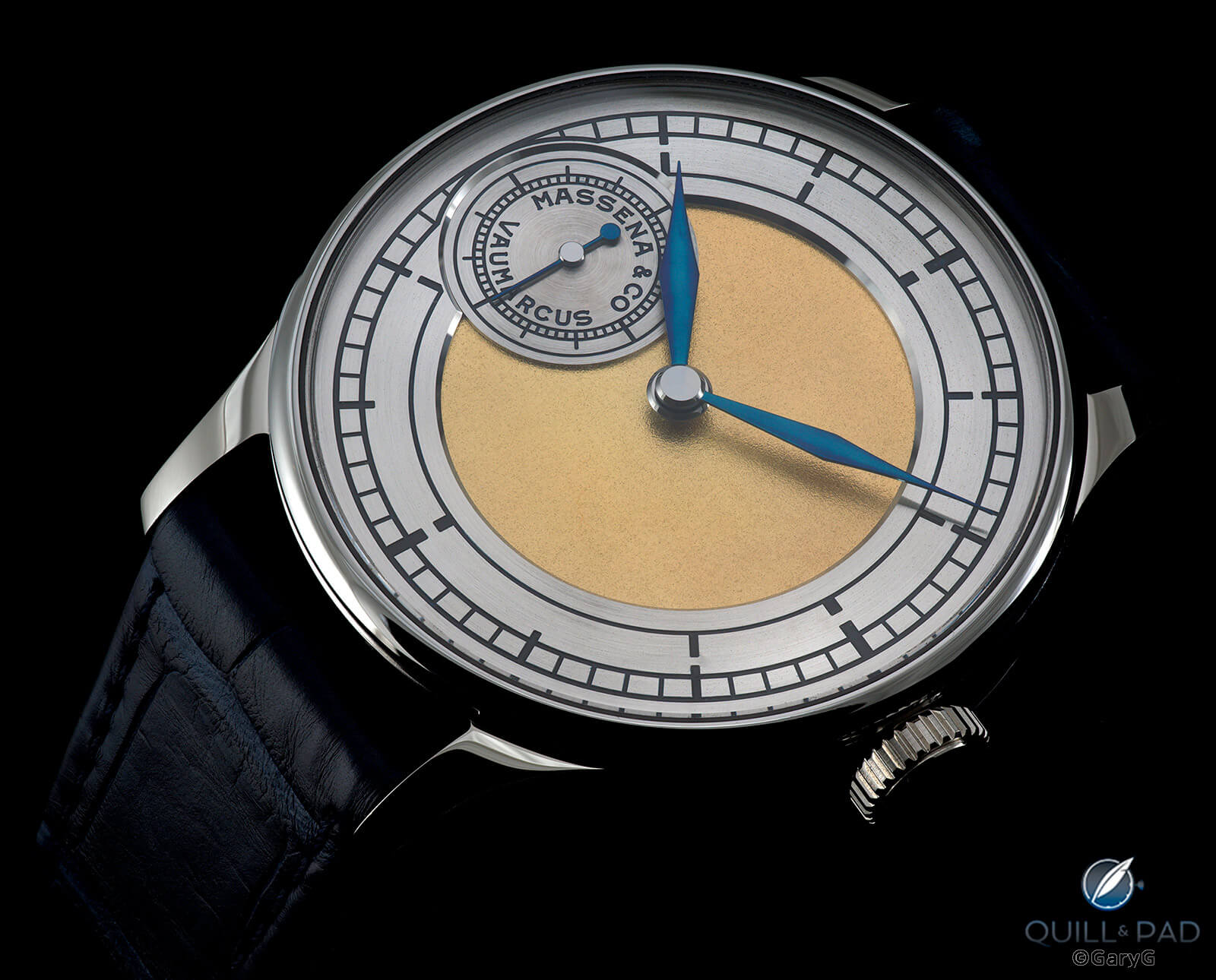
Looks big, wears big: Old School from Luca Soprana and Massena Lab
Second thing: if you’ve read this far (thanks!) and are ready to plop down your money, I have bad news: the limited edition of 11 pieces sold out immediately upon launch, so neither you nor I are getting one.
The good news: on the Massena Lab website, Old School is identified as the “first collaboration” between Massena and Soprana. So if you are taken by the looks of this piece and appreciate the dedication to handwork applied by Soprana to his creations, stay tuned as it seems we can expect more to come!
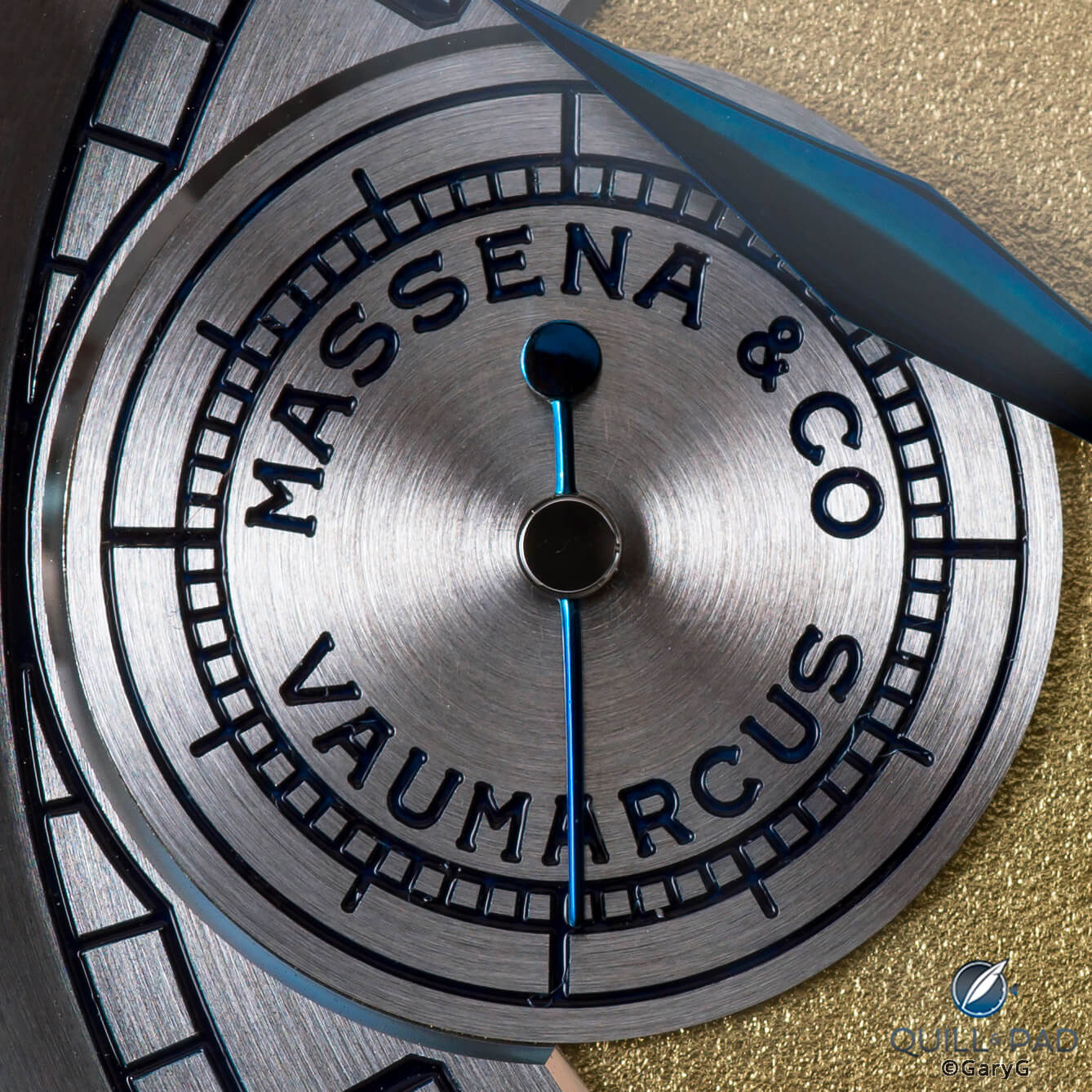
Parting shot: dial detail with Massena and Soprana’s Vaumarcus scripts shown in “old style”
For more information, please visit massenalab.com/products/old-school-by-massena-lab-and-luca-soprana.
Quick Facts Old School by Massena Lab and Luca Soprana
Case: 41.5 x 11 mm, stainless steel with polished bezels and lugs and brushed case band; flat, anti-glare front crystal and exhibition back with sapphire crystals; crown made by hand; water resistance 30 meters
Dial and hands: German silver with 2N gold-plated, hand-frosted center section and rhodium-plated sector design outer ring and seconds subdial; midnight-blue markings; hand-filed, blued steel hands
Movement: manually wound Caliber LS-01 by Luca Soprana; blued steel balance spring and bimetallic balance; swan-neck regulator and micro-metric screw; 40-hour power reserve; 18,000 vph/2.5 Hz frequency
Functions: hours, minutes, subsidiary seconds
Limitation: 11 pieces, sold out
Price: $39,500
Production years: 2021-22
You may also enjoy:
GaryG’s 2021 Year In Review: Acquisitions, Events, Trends To Watch, And Even Some Swag
Behind The Lens: 3 Watches From Massena Lab
MB&F, L’Épée 1839, Massena Lab’s T-Rex Bronze: The Missing Link
Leave a Reply
Want to join the discussion?Feel free to contribute!





















































I guess Massena subscribes to the old W.C. Field’s line, “Never give a sucker an even break.”
Hi Ron — not entirely sure what your comment is about…not all of us can afford a Greubel Forsey Hand Made at a million bucks, and relative to its price point I see this watch as being an entirely fair effort.
Best, Gary
I watched “Gremlins” at Christmas.
Yum yum!! 😁
A bit late but exploring this watchmaker and saw your review man those shots are stunning but of all things things in this watch those blued hands are making me look at the timepiece again and again . its a great indepth review you tried to give an insight into watchmaker really appreciate your work will explore more of your writings here , thank you.